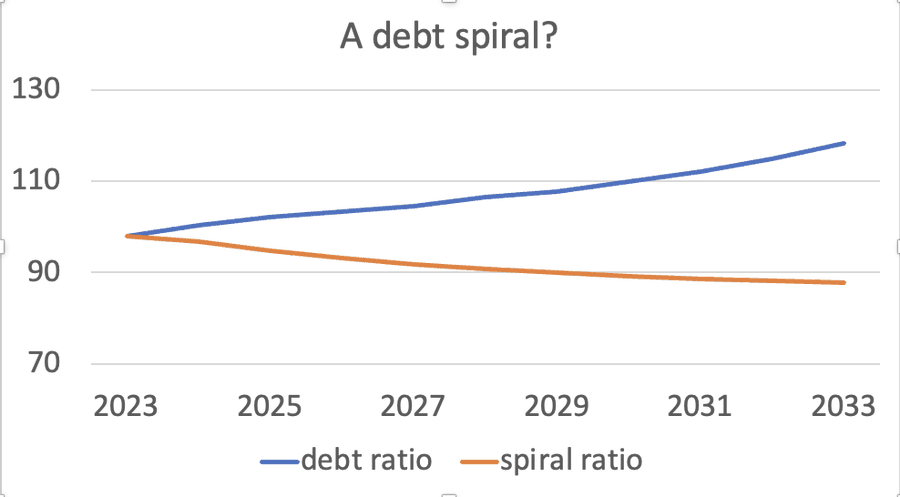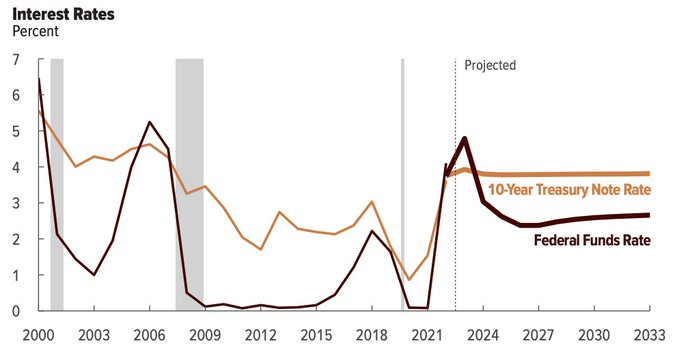債務スパイラルの懸念を否定する連ツイをクルーグマンが立てている。
Thinking about debt, and some common misconceptions. I thought I'd start with a picture that needs explaining, although it's just a new way to make a point many economists — but not many other people — already know 1/
What got me started was the mail I get every time I write about debt and the debt ceiling — stuff along the lines "you forgot to mention that debt is 100% of GDP and debt service is rising". Of course I didn't forget. But this sort of thing reflects two big misunderstandings 2/
First is that 100% is an especially significant number, and historically unprecedented. But it's a ratio of a stock to a flow; it depends on the convention of measuring GDP on an annual basis. If we used quarterly it would be 400%! 3/
And it's not at all unprecedented, Contemporary Japan is of course far higher. But also note that Britain achieved the Industrial Revolution with debt far above current US levels 4/
Beyond that, many people seem to think that we're heading for a debt spiral: more debt means more interest payments, which requires more borrowing, which means even more debt, and off we go. Sounds intuitive ... but 5/
It's true that CBO projects both a rise in debt/GDP and a rise in debt service/GDP over the next decade. But much of the latter rise doesn't reflect higher debt; it reflects the *assumption* that interest rates will stay high 6/
And even so CBO isn't projecting a debt spiral: the rising debt ratio is the result of projected primary (non-interest) deficits, not interest accumulation. 7/
To show this, I asked what would happen to debt using CBO's projected interest rates, but without primary deficits, so that debt accumulation would come purely from borrowing to pay interest — a pure debt spiral. Again, the picture 8/
So no debt spiral. Economists will know that this is because despite CBO's assumption that rates will stay high, we're still in an r<g world. This is just a different way of making the point. 9/
No doubt some of the responses, if any, will be "But debt is 100% of GDP and debt service is rising!" But I do not think those numbers mean what you think they mean 10/
(拙訳)
債務、および、良くある誤解について考えてみる。追加説明が必要な図から始めてみようかと思うが、ただしこれは、多くの経済学者にとっては既知のことながら、多くの人にとってはそうでないことを強調する新たな方法に過ぎない。
このスレッドを立てたきっかけは、債務と債務上限について書くたびに受け取るメールである。そうしたメールには「貴兄は債務がGDPの100%になっていること、および、元利払い費用が上昇していることを言及し忘れている」といったことが書かれている。もちろん私は忘れたわけではなく、そうした話には2つの大きな誤解が反映されている。
一つ目の誤解は、100%というのが特に重要な数字であり、過去に前例が無い、というものだ。しかしそれはストックとフローの比率であり、GDPを年次で測定するという慣行に依存している。四半期を使うならば、その数字は400%になるのだ!
そして前例が無いわけではまったくない。現在の日本はもちろん遥かに高い。また今の米国を大きく上回る債務水準で英国が産業革命を達成したことも覚えておくべきだろう。
あと、我々は債務スパイラルに向かっていると多くの人が考えているようである。債務が多ければ利払い費も多くなり、そのため借り入れが増え、債務がさらに拡大し、箍が外れてしまう、というわけだ。これは直観的に正しいように思われる…。しかし、だ。
CBOが、今後10年間に債務GDP比率ならびに元利払い費用のGDP比率の両方が上昇する、と予測しているのは事実だ。だが後者の上昇の多くは債務の増加を反映したものではない。それは金利が高止まりするであろうという想定を反映したものだ。
しかもその場合でもCBOは債務スパイラルを予測していない。債務比率の上昇は、予測された基礎的(非利払い)財政赤字の結果であり、利払いが積み重なった結果ではない。
そのことを示すため、CBOの予測金利を用いて、基礎的財政赤字が無い場合、従って債務の蓄積が利払いのための借り入れだけから生じる場合、債務がどうなるかを訊いてみた。純粋な債務スパイラル、ということになる。図を再掲する。
ということで、債務スパイラルは起きない。経済学者はそのことが分かっている。というのは、金利が高止まりするというCBOの想定にもかかわらず、我々は未だr<gの世界にいるからだ。これはそのことを示す別法に過ぎない。
「でも債務はGDPの100%だし元利払い費用は上昇しているではないか!」という反応がまた来るのはまあ間違いなかろう。だがそうした数字が意味することがあなた方が考えていることだとは私は思わない。

